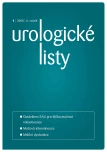Validation of the overactive bladder symptoms score (OABSS)
Authors:
Jerry G Blaivas; Md 1,2,3; Georgia Panagopoulos; Md 2; Jeffrey P Weiss; Md 1,2,3; Chandra Somaroo; Md 3
Published in:
Urol List 2008; 6(1): 20-24
Overview
Purpose:
To validate a new 7-item Overactive Bladder symptom score (OABSS).
Materials & Methods:
Normal subjects and consecutive patients with LUTS, with or without OAB were recruited and classified into 3 groups based on their response to the following question on an intake questionnaire, „do you ever experience a sudden urge to urinate that makes you want stop what you are doing and rush to a bathroom?“ Subjects completed the written questionnaire in privacy on two separate occasions.
Results:
There were 84 subjects (33 men and 51 women) with a median age 62 years (range 18–88). Thirty-three (39 %) had OAB, 30 (36 %) had LUTS without OAB and 21 (25 %) were normal. There was a high level of internal consistency (Cronbach's alpha = 0.83 and 0.80 at visit 1 and visit 2, respectively, p < 0.001). For test-retest reliability, Spearman's rank order correlation coefficients for the items ranged from r = 0.72 to r = 0.79 (p < 0.001). A strong correlation was also observed between the total 7-item score at visit 1 and visit 2 for all participants (r = 0.86, p < 0.001) and for each diagnostic subgroup. Discriminant validity was established by obtaining significant differences in the responses amongst the three subgroups at each administration (p < 0.01).
Key words:
OAB, symptom score, validation
Sources
1. Abrams P, Cardozo L, Fall M et al. The standardisation of terminology of lower urinary tract function: report from the Standardisation Sub-committee of the International Continence Society. Neurourol Urodyn 2002; 21(2): 167-178.
2. Blaivas J, Panagopoulos G, Weiss JP et al. The urgency perception score (UPS); validation & testretest. J Urol 2007; 177 : 199-202.
3. De Wachter S, Wyndaele JJ. Frequency-volume charts: a tool to evaluate bladder sensation. Neurourol Urodyn 2003; 22(7): 638-642.
4. Jonovan J, Bosch R, Gotoh M et al. Symptom and Quality of Life Assessment, Committee 6. In: Abrams P, Cardozo L, Khoury S (ed). Incontinence. 2nd Ed. UK: Health Publication, Ltd 2005.
5. Avery K, Donovan J, Peters TJ et al. ICIQ: a brief and robust measure for evaluating the symptoms and impact of urinary incontinence. Neurourol Urodyn 2004; 23(4): 322-330.
6. Donovan JL, Peters TJ, Abrams P et al. Scoring the short form ICSmaleSF questionnaire. International Continence Society. J Urol 2000; 164(6): 1948-1955.
7. Coyne K, Revicki D, Hunt T et al. Psychometric validation of an overactive bladder symptom and health related quality of life questionnaire; the OAB-q. Qual Life Res 2003 : 563-574.
8. Shumaker SA, Wyman JF, Uebersax JS et al. Healthrelated quality of life measures for women with urinary incontinence: the Incontinence Impact Questionnaire and the Urogenital Distress Inventory. Continence Program in Women (CPW) Research Group. Qual Life Res 1994; 3(5): 291-306.
9. Uebersax JS, Wyman JF, Shumaker SA et al. Short forms to assess life quality and symptom distress for urinary incontinence in women: the Incontinence Impact Questionnaire and the Urogenital Distress Inventory. Continence Program for Women Research Group. Neurourol Urodyn 1995; 14(2): 131-139.
10. Sandvik H, Hunskaar S, Seim A et al. Validation of a severity index in female urinary incontinence and its implementation in an epidemiological survey. J Epidemiol Community Health 1993; 47(6): 497 - 499.
11. Jackson S, Donovan J, Brookes S et al. The Bristol Female Lower Urinary Tract Symptoms questionnaire: development and psychometric testing. Br J Urol 1996; 77(6): 805-812.
12. Donovan JL, Abrams P, Peters TJ et al. The ICS - 'BPH' Study: the psychometric validity and reliability of the ICSmale questionnaire. Br J Urol 1996; 77(4): 554-562.
13. Hald T, Nordling J, Andersen JT et al. A patient weighted symptom score system in the evaluation of uncomplicated benign prostatic hyperplasia. Scand J Urol Nephrol 1991; 138(Suppl): 59-62.
14. Chapple CR, Artibani W, Cardozo LD et al. The role of urinary urgency and its measurement in the overactive bladder symptom syndrome: current concepts and future prospects. BJU Int 2005; 95(3): 335-340.
15. Nixon A, Coleman S, Sabounjian L et al. A validated patient reported measure of urinary urgency severity in overactive bladder for use in clinical trials. J Urol 2005; 174(2): 604-607.
16. Oliver S, Fowler C, Mundy A, Craggs M. Measuring the sensations of urge and bladder filling during cystometry in urge incontinence and the effects of neuromodulation. Neurourol Urodyn 2003; 22(1): 7-16.
17. Zinner N, Harnett M, Sabounjian L et al. The overactive bladder-symptom composite score: a composite symptom score of toilet voids, urgency severity and urge urinary incontinence in patients with overactive bladder. J Urol 2005; 173(5): 1639-1643.
18. Kelleher CJ, Cardozo LD, Khullar V, Salvatore S. A new questionnaire to assess the quality of life of urinary incontinent women. Br J Obstet Gynaecol 1997; 104(12): 1374-1379.
19. Stach-Lempinen B, Kirkinen P, Laippala P et al. Do objective urodynamic or clinical findings determine impact of urinary incontinence or its treatment on quality of life? Urology 2004; 63(1): 67-71; discussion 71-72.
20. Brummen HJ, Heintz AP, Vaart CH. The association between overactive bladder symptoms and objective parameters from bladder diary and filling cystometry. Neurourol Urodyn 2004; 23(1): 38-42.
Labels
Paediatric urologist UrologyArticle was published in
Urological Journal

2008 Issue 1
Most read in this issue
- Pelvic organ prolapse in women from the viewpoint of a urologist
-
Kolposuspenze dle Burche – zlatý standard v operacích ženské močové inkontinence
Současná urogynekologická operativa I - The Pathophysiology of Large Capacity Bladder
- Urological consequences of gynaecological surgeries
